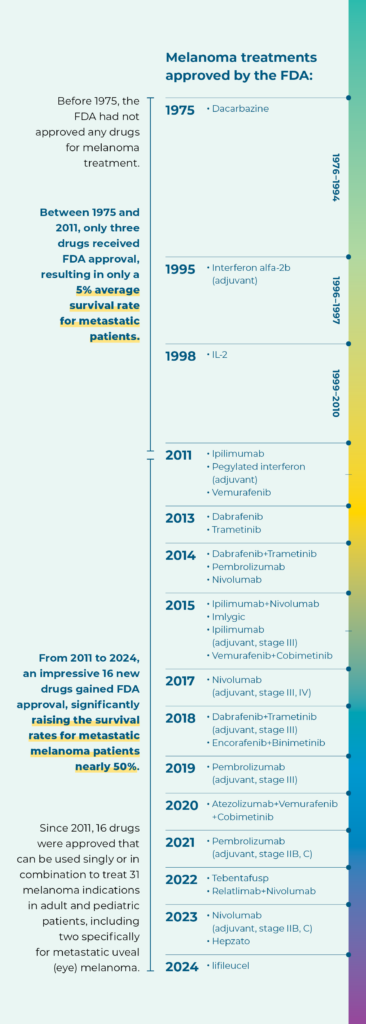Research & Science
Accelerating medical RESEARCH while EDUCATING to and ADVOCATING for the melanoma community.
Although we have achieved a number of important scientific milestones, much more work remains to be done in cutaneous melanoma as well as ocular and other rare melanoma subtypes. For more information on our broad scientific portfolio, download the MRF Research Portfolio.
Visit the Why Research Matters blog to hear the important perspectives of patients and researchers.
1: National Cancer Institute (NCI) SEER (Surveillance, Epidemiology, and End Results) Program

Upcoming RFPs
2024 Research Grants
Multiple grant opportunities are currently accepting applications for 2024 research funding, with deadlines beginning in February. Visit the Grants RFP page to learn more and apply.

Find a Clinical Trial
How do I find a Melanoma Clinical Trial?
There are many ways you can learn about available clinical trials, which hospitals are participating in clinical trials, and how to enroll. The two easiest ways are through the use of the MRF’s Clinical Trial Finder or through ClinicalTrials.gov.

Upcoming Meetings
Next Melanoma Meeting: American Association of Clinical Oncology will be held May 31 – June 4, 2024.
In addition to the melanoma meetings that the MRF sponsors, the MRF also hosts events in conjunction with the larger oncology meetings listed below.
- AACR (American Association for Cancer Research): April 5-10
- ASCO (American Association of Clinical Oncology): May 31 – June 4
- SMR (Society for Melanoma Research): October 10-13
- SITC (Society for Immunotherapy of Cancer): November 6-10
Learn More about the MRF’s Diverse Scientific Agenda Below
MRF Research Portfolio
Learn more about our commitment to melanoma science by reading the MRF Research Portfolio.
Research Grants
Established in 1998, the MRF research grants are a competitive, peer-reviewed program for investigator-initiated research conducted under the purview of our Scientific Advisory Committee. MRF-supported research is open to medical students through senior investigative teams and encompass not only cutaneous melanoma, but also the rare melanoma types such as uveal, mucosal and pediatric melanoma.
Learn MoreScientific Initiatives
Responding to needs in the field, the MRF has spearheaded several scientific initiatives to accelerate research and treatments focused on the most common malignant tumor of the eye and initiatives that focus on rare melanoma subsets such as pediatric and mucosal, and the conduct of various scientific meetings.
- CURE OM Patient Registry
- MRF Breakthrough Consortium
- CURE Ocular Melanoma
- Pediatric & Mucosal Melanoma
- Scientific Meetings
- Partnerships
Learn More
Participate in Science
If you are looking for a way to get involved in melanoma research, you can participate in any number of ways – through a clinical trial, as a research advocate, in the grant review process, and/or through fundraising. Consider getting involved today!
Learn More
Scientific Leadership
The MRF’s Scientific Leadership is comprised of multidisciplinary experts in basic and translational research, dermatology, epidemiology, genomics, pathology, surgery and medical oncology. Members of all our advisory/ steering committees are volunteers that assist in providing the scientific direction of the MRF.
Learn More
Why Research Matters
From discovery in the laboratory to clinical trials, science can make a difference in the lives of people touched by melanoma. Click below to meet a patient and researcher directly involved in melanoma science and read their stories.
Mucosal Melanoma Awareness
FDA Approved Melanoma Treatments
Recent research advances have greatly improved the lives of melanoma patients. Before 1975, the FDA had not approved any drugs for melanoma treatment. Between 1975-2011, this number increased to only three FDA approvals. However, since 2011, the FDA has approved SIXTEEN new drugs (used singly or in combination) to treat THIRTY-ONE different melanoma indications. This has resulted in increasing the survival rate for metastatic melanoma patients from 5 to almost 50%. A summary of this timeline is outlined below:




